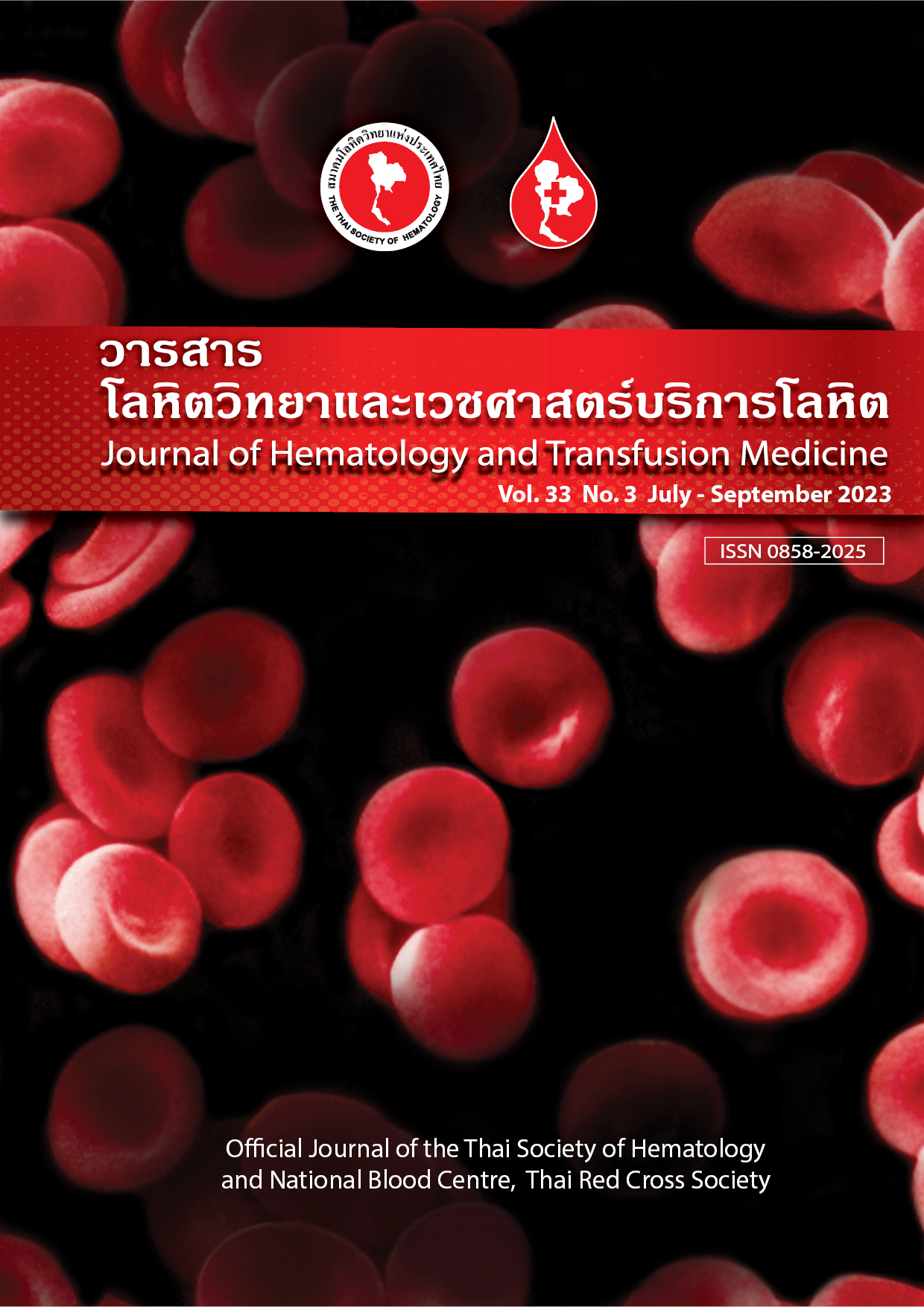Comparison between complement-dependent cytotoxicity and flow cytometry crossmatches in deceased donor kidney transplantation
Keywords:
Complement-dependent cytotoxicity, Flow cytometry, Crosssmatch, Kidney transplantation, โฟลว์ไซโตเมทรี, การตรวจความเข้ากันได้, การปลูกถ่ายไตAbstract
Abstract:
Introduction: Complement-dependent cytotoxicity crossmatch (CDC-XM) and CDC-antihuman globulin-XM (CDC-AHG-XM) have been widely employed to detect donor-specific antibodies in recipients on the waiting list before proceeding with deceased donor kidney transplantation. The flow cytometric crossmatch (FC-XM) has been introduced, and providing increased sensitivity and less time-consumption compared with both assays. Objective: This study aimed to compare the standard CDC-AHG-XM and the three-color FC-XM in deceased donor kidney transplants and to evaluate their sensitivity and specificity. Materials and Methods: Altogether, 365 non-repeated serum samples were included from patients who were candidates for deceased donor kidney transplantation according to the Organ Donation Centre of the Thai Red Cross Society (ODC-TRCS) allocation score. Patient serum samples were crossmatched using CDC-XM, CDC-AHG-XM and FC-XM with T and B lymphocytes obtained from 50 deceased donors. The HLA class I and II antibodies in each patient were also determined. Results: The crossmatch results obtained by FC-XM were compared with the standard CDC-AHG-XM. The sensitivity and specificity of FC-XM in T and B cells were 100 and 100% and 98.86 and 99.41%, respectively. Although FC-XM requires high technical expertise to perform the test, its applications could reduce testing time from 6 to less than 2 hours compared with CDC-AHG-XM. This would be helpful in improving transplant allocation and patient care. Conclusion: In this study, we evaluated the three-color FC-XM and compared the crossmatch results with the routinely used CDC-AHG-XM. The FC-XM is equal to or better than the CDC-AHG-XM because it requires fewer testing steps and is less time-consuming, which is beneficial in deceased donor kidney transplantation.
บทคัดย่อ
บทนำ วิธี complement-dependent cytotoxicity crossmatch (CDC-XM) และ CDC-antihuman globulin-XM (CDC-AHG-XM) ได้นำมาใช้เพื่อตรวจแอนติบอดีในผู้ป่วยรอปลูกถ่ายไตที่จำเพาะต่อผู้บริจาค ก่อนการปลูกถ่ายไตจากผู้บริจาคไตสมองตาย วัตถุประสงค์ เพื่อเปรียบเทียบการตรวจ CDC-AHG-XM กับ
โฟลว์ไซโตเมทรีสามสี (FC-XM) ก่อนการปลูกถ่ายไต รวมทั้งประเมินความไวและความจำเพาะ วัสดุและวิธีการ ซีรัมผู้ป่วยที่ได้คัดเลือกมาตรวจความเข้ากันได้ตามเกณฑ์ของศูนย์รับบริจาคอวัยวะสภากาชาดไทย จำนวน 365 รายโดยใช้วิธี CDC-XM, CDC-AHG-XM และ FC-XM กับ T และ B lymphocytes ของผู้บริจาคไตจำนวน 50 ราย ทั้งนี้ผู้ป่วยแต่ละรายได้ตรวจแอนติบอดีต่อ HLA class I และ class II แล้ว ผลการศึกษา เมื่อเปรียบเทียบการตรวจความเข้ากันได้ด้วย FC-XM กับ CDC-AHG-XM พบว่า วิธี FC-XM มีความไวและความจำเพาะ เท่ากับ 100 และ 100% และ 98.86 และ 99.41% สำหรับ T และ B cells ตามลำดับ แม้ว่า FC-XM ต้องใช้บุคลากรที่มีประสบการณ์สูงในการตรวจ แต่การประยุกต์ใช้วิธีนี้สามารถลดเวลาในการตรวจจาก 6 ชั่วโมง เป็นน้อยกว่า 2 ชั่วโมง จึงเป็นประโยชน์ต่อการจัดสรรเพื่อการปลูกถ่ายไต และการดูแลรักษาผู้ป่วย สรุป การศึกษานี้ผู้วิจัยได้ประเมิน FC-XM และเปรียบเทียบผลการตรวจความเข้ากันได้กับวิธีตรวจประจำ CDC-AHG-XM การใช้ FC-XM มีผลการตรวจเทียบเท่าหรือดีกว่าการตรวจด้วย CDC-AHG-XM เนื่องจากขั้นตอนการตรวจและเวลาที่ใช้น้อยกว่า ซึ่งมีประโยชน์ในการปลูกถ่ายไตจากผู้บริจาคไต
สมองตาย
Downloads
References
O-Charoen R, Kupatawintu P. Selection criteria for transplantation. In: Jirasiridham S, editor. Textbook of kidney donation for transplantation. Bangkok: Krungthepvejchasarn; 2001. p. 14-21.
O-Charoen R, Kupatawintu P, Sinsiri S, Salee S, Tatawatorn A, Nathalang O, et al. Preliminary results of selection criteria for cadaveric kidney transplantation by the Thai Red Cross. Transplant Proc. 2000;32:1574-5.
Chinbordee K, Kukhuntod D, Tatawatorn A, Phiencharoen S, Attajarusit Y, Dhitavat V, et al. Pre-transplant factors influencing HLA crossmatch in deceased donor kidney transplantation. J Hematol Transfus Med. 2020;30:247-53.
Patel R, Terasaki PI. Significance of the positive crossmatch test in kidney transplantation. N Engl J Med. 1969;280:735-9.
Kissmeyer-Nielsen F, Olsen S, Petersen VP, Fjeldborg O. Hyper-acute rejection of kidney allograft, associated with pre-existing humoral antibodies against donor cells. Lancet. 1966;2:662.
Tait BD, Susal C, Gebel HM, Nickerson PW, Zachary AA, Claas FH, et al. Consensus guidelines on the testing and clinical management issues associated with HLA and non-HLA antibodies in transplantation. Transplantation. 2013;95:19-47.
Mahoworld GK. The CDC crossmatch in the era of flow cytometric crossmatch and single antigen beads. Braz J Nephrol. 2021;43:299-300.
Irish WD, Ilsley JN, Schnitzler MA, Feng S, Brennan DC. A risk prediction model for delayed graft function in the current era of deceased donor renal transplantation. Am J Transplant. 2010;10:2279-86.
Ponticelli CE. The impact of cold ischemia time on renal transplant outcome. Kidney Int. 2015;87:272-5.
Kayler L, Yu X, Cortes C, Lubetzky M, Friedmann P. Impact of cold ischemia time in kidney transplants from donation after circulatory death donors. Transplant Direct. 2017 23;3:e177. doi: 10.1097/TXD.0000000000000680.
Garavoy MR, Rheinschmidt MA, Bigos M, Perkins H, Colombe B, Feduska N, et al. Flow cytometry analysis: a high technology crossmatch technique facilitating transplantation. Transplant Proc. 1983;15:1939-44.
Bray RA, Lebeck LK, Gebel HM. The flow cytometric crossmatch. Dual-color analysis of T cell and B cell reactivities. Transplantation. 1989;48:834-40.
O'Rourke RW, Osorio RW, Freise CE, Lou CD, Garovoy MR, Bacchetti P, et al. Flow cytometry crossmatching as a predictor of acute rejection in sensitized recipients of cadaveric renal transplants. Clin Transplant. 2000;14:167-73.
Karpinski M, Rush D, Jeffery J, Exner M, Regele H, Dancea S, et al. Flow cytometric crossmatching in primary renal transplant recipients with a negative anti-human globulin enhanced cytotoxicity crossmatch. J Am Soc Nephrol. 2001;12:2807-14.
Koktathong K, Vejbaesya S, Bejrachandra S, Pattanapanyasat K. Flow cytometric crossmatch for kidney transplantation. J Med Assoc Thai. 2005;88:769-74.
Chamsai S, Kittisares K, Thanaketpaisarn Y, Ngamthawornwong S, Koktathong K. Evaluation of the three-colored flow cytometric crossmatch assay in living-related kidney transplantation. J Hematol Trasfus Med. 2018;28:239-48.
Liwski RS, Greenshields AL, Conrad DM, Murphey C, Bray RA, Neumann J, et al. Rapid optimized flow cytometric crossmatch (FCXM) assays: the Halifax and Halifaster protocols. Hum Immunol. 2018;79:28-38.
Ilham MA, Winkler S, Coates E, Rizzello A, Rees TJ, Asderakis A. Clinical significance of a positive flow crossmatch on the outcomes of cadaveric renal transplants. Transplant Proc. 2008;40:1839-43.
Orandi BJ, Garonzik-Wang JM, Massie AB, Zachary AA, Montgomery JR, Van Arendonk KJ, et al. Quantifying the risk of incompatible kidney transplantation: a multicenter study. Am J Transplant. 2014;14:1573-80.
LeFor WM.ASHI laboratory manual. 4th ed. New Jersey: American Society of Histocompatibility and Immunogenetics; 2000.
Ounjai S, Ponraweethitikorn P, Kanunthong S, Srisuddee A, Phiencharoen S, Kupatawintu P, et al. HLA-A, -B, and -DR frequencies in deceased kidney donors of the Organ Donation Centre, Thai Red Cross Society. J Hematol Transfus Med. 2019;29:175-81.
Srisuddee A, Tupmongkol T, Thongpaknam S, Phiancharoen S, Kupatawintu P, Nathalang O, et al. HLA mismatch between deceased donors and kidney transplant recipients: a retrospective study from January 2019 to December 2021. J Hematol Transfus Med. 2022;32:193-200.
Downloads
Published
Issue
Section
License
Copyright (c) 2023 Journal of Hematology and Transfusion Medicine

This work is licensed under a Creative Commons Attribution-NonCommercial-NoDerivatives 4.0 International License.



